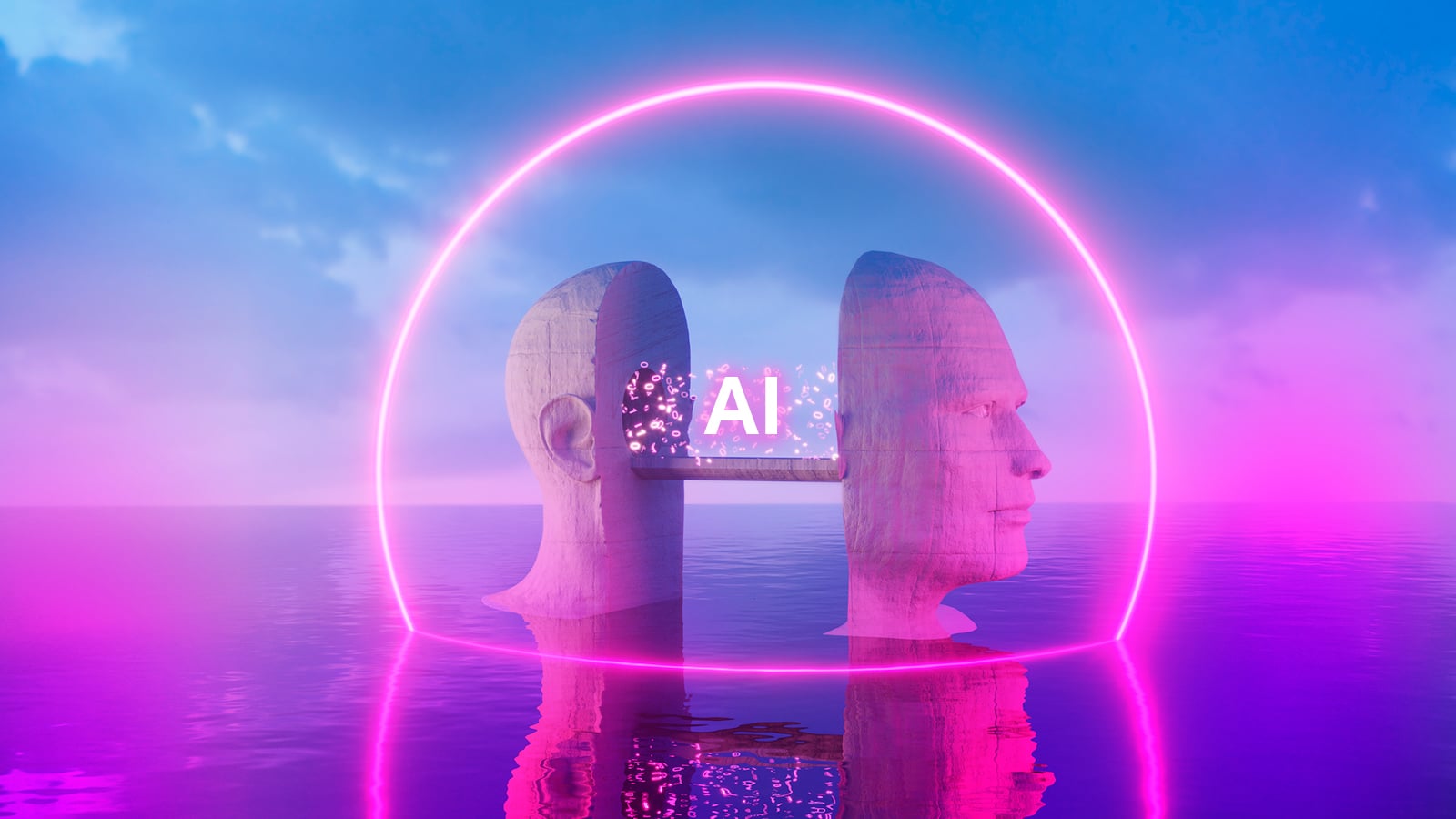Perhaps no topic has dominated the creative discourse in recent months more than AI-powered software programs like Midjourney and ChatGPT. Though still relatively early in their development, the platforms have demonstrated both remarkable creative possibilities and the undiminished need for the human creative talent that is driving it.
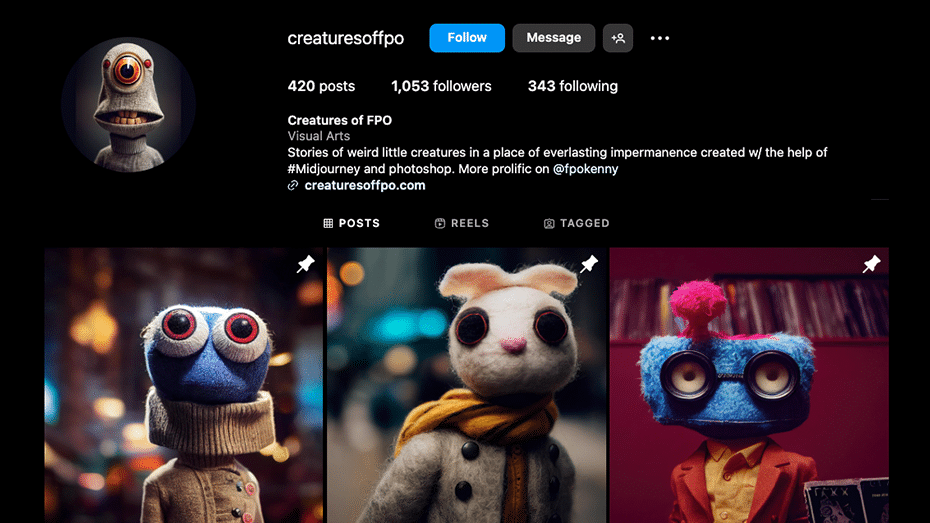
Leap Group Executive Creative Director Kenny Friedman was an early adopter of generative AI technologies, first using it to create his own beautifully weird Creatures of FPO (a delightfully surreal take on Humans of New York) before implementing it with his own agency creative teams. When he began posting thought leadership pieces on AI on his LinkedIn account, Kenny started receiving multiple requests to teach AI workshops for creatives. And while Kenny no longer offers workshops for outside agencies, he has conducted several AI seminars for Leap Group Network agencies. We sat down with him to learn more about his own AI journey, how creative teams can implement it, and why human intelligence still rules.
You began your career as a photographer, so what drew you to AI?
I started with generative AI in January 2022, which was pretty early for normal folks, and it was something I did because it was an artistic toy. At the time, bored ape NFTs were really popular, so I would make those and then I started making portraits of people on my team. I got these grotesque, yet incredibly beautiful images, and that’s when I realized you can do weird stuff with AI and began to take a more serious interest in it.
I saw some people doing interesting things with Midjourney, so I got on the waitlist and was admitted in early June 2022. I think they were still on version 2, and it wasn’t good. But then somehow, I found these awesome little creatures that I call Creatures of FPO. It was a mistake, because I didn’t know the language to use, and it’s a weird, long process to make these guys, but that’s what hooked me, and that’s all I did with AI for months.
How did you start integrating AI with your role as a creative director?
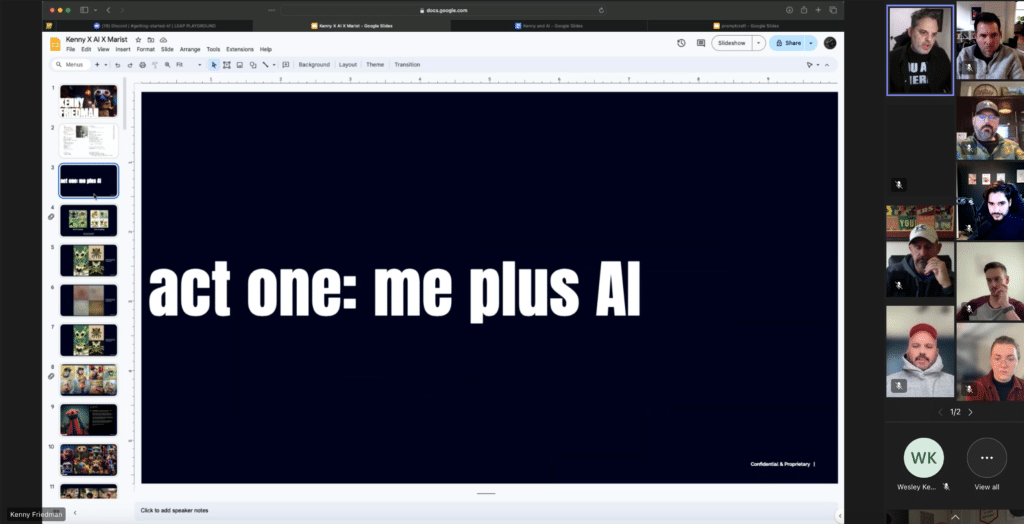 I had that aha moment in July or August 2022. I realized, this is going to change everything that we do, because timelines are shrinking and we need to get to round ones and round twos quicker, and AI could help us ideate better and faster. That’s when I started teaching my team how to use Midjourney. And I got a lot of pushback at first – maybe people were scared of it, or not used to it – but I started talking about it a lot on LinkedIn, and I had somebody reach out and ask if I could teach their team to use AI.
I had that aha moment in July or August 2022. I realized, this is going to change everything that we do, because timelines are shrinking and we need to get to round ones and round twos quicker, and AI could help us ideate better and faster. That’s when I started teaching my team how to use Midjourney. And I got a lot of pushback at first – maybe people were scared of it, or not used to it – but I started talking about it a lot on LinkedIn, and I had somebody reach out and ask if I could teach their team to use AI.
I saw some people doing interesting things with Midjourney, so I got on the waitlist and was admitted in early June 2022. I think they were still on version 2, and it wasn’t good. But then somehow, I found these awesome little creatures that I call Creatures of FPO. It was a mistake, because I didn’t know the language to use, and it’s a weird, long process to make these guys, but that’s what hooked me, and that’s all I did with AI for months.
That kept happening, and before long I had several presentations under my belt. My teaching was a combination of not only how to use AI, but also when it’s most useful in the creative process. It’s great for logo design, even though it doesn’t know how to read words, because my team could spit out hundreds of logos in a couple hours instead of three pixel-perfect logos in a week, and then I could react to it. And that’s what I was teaching agencies. AI is not only this tool you can use to get inspiration, but to do your round one creative review: you can show logos, you can show website designs, anything. It’s still you doing the work, it’s you putting in the prompt, editing it, showing it to your creative director, having that person react to it, and then taking the versions they like and making them. It’s still a really organic process.
What do you say to clients who think they don’t need designers anymore?
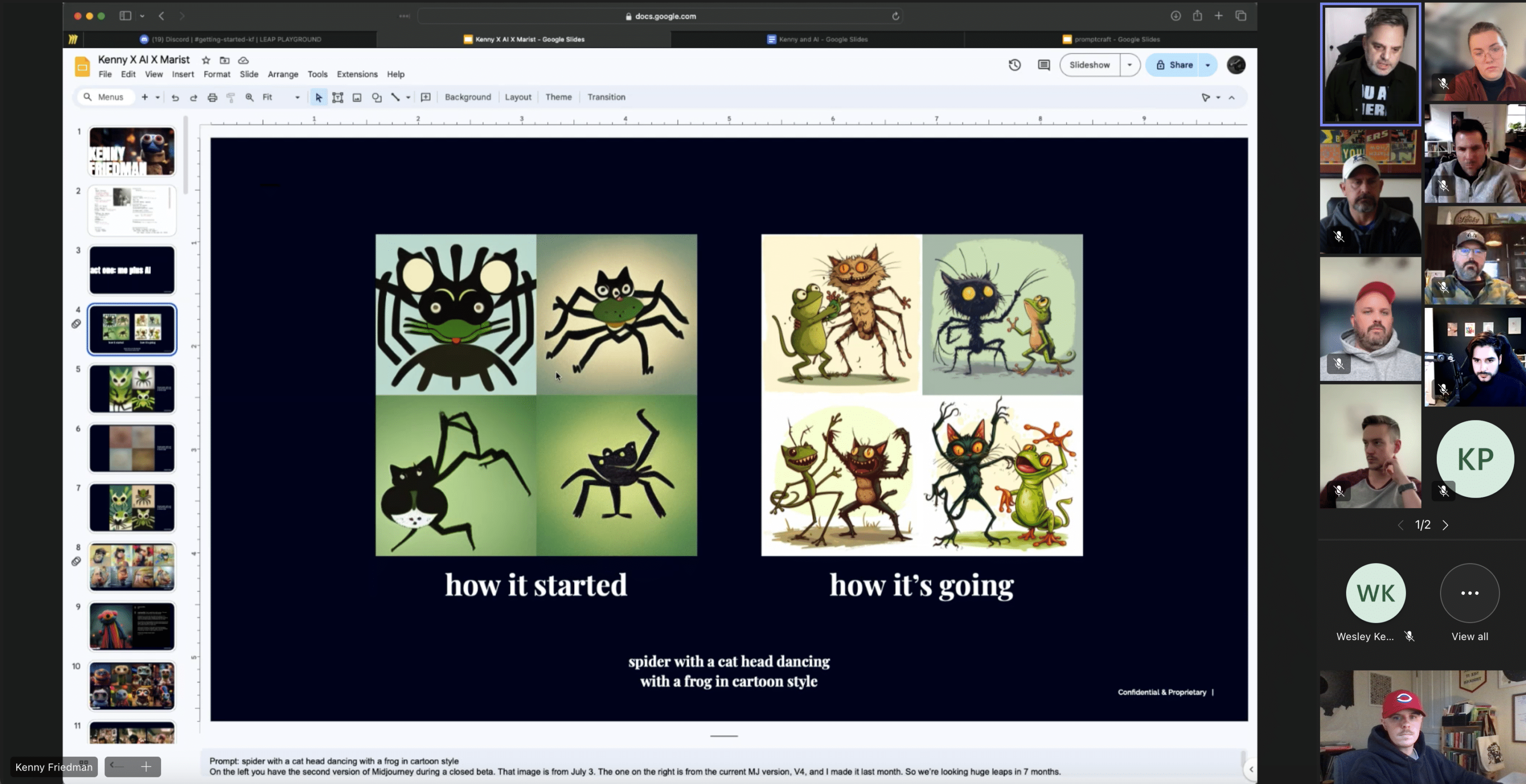 The thing is, AI only understands averages. That’s how it works. It learns what a cat is, and then it gives you back the average image of a cat. Most people who are using AI don’t know how to push it, so they’re getting back average images. So yes, you can use AI to generate a logo, and it might be a beautiful logo, but it will be average. It won’t be anything new. And that’s fine for a small business. Canva is amazing for small businesses who can’t afford an agency.
The thing is, AI only understands averages. That’s how it works. It learns what a cat is, and then it gives you back the average image of a cat. Most people who are using AI don’t know how to push it, so they’re getting back average images. So yes, you can use AI to generate a logo, and it might be a beautiful logo, but it will be average. It won’t be anything new. And that’s fine for a small business. Canva is amazing for small businesses who can’t afford an agency.
But to truly get something new and break through all the average stuff that’s out there, you need the human part of it. And that could be in two ways: first, knowing how to really get into the AI and push it and bend it so that you get something unique and unexpected. Second, you need a human designer to take what you like and then actually create a polished version of it.
What kind of people have you AI workshops attracted, and what were they interested in learning?
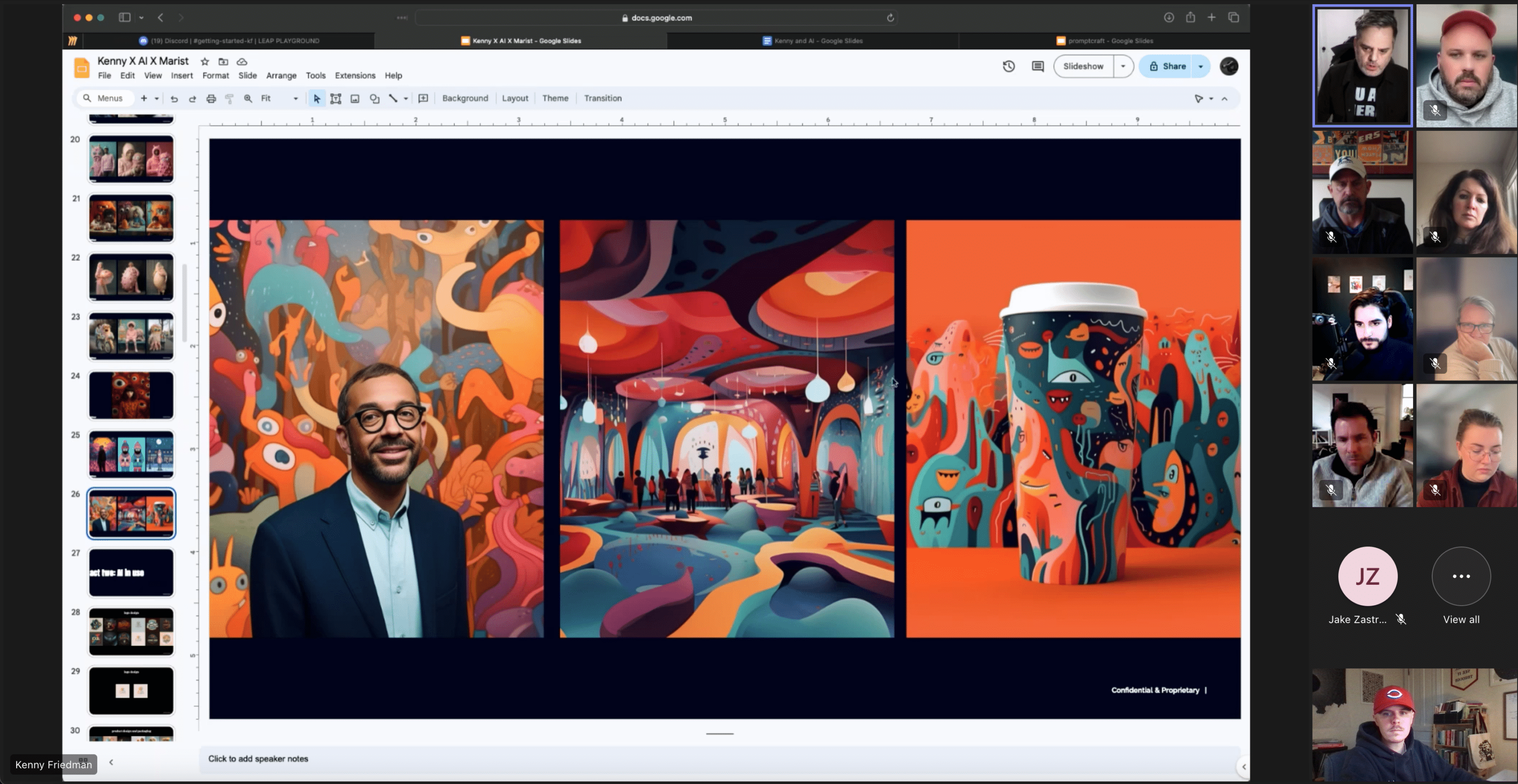 I don’t teach agencies anymore, but when I did, it was mostly smaller to mid-size agencies with fewer than 80 people. I think the big holding companies are scared to use it or they’re dragging their feet, but then you have these smaller ones that say, we’re going to use AI, we’re going to be honest with our clients about it, we’re going use it for ideation. Honestly, those were my best clients because they were so enthusiastic about the technology.
I don’t teach agencies anymore, but when I did, it was mostly smaller to mid-size agencies with fewer than 80 people. I think the big holding companies are scared to use it or they’re dragging their feet, but then you have these smaller ones that say, we’re going to use AI, we’re going to be honest with our clients about it, we’re going use it for ideation. Honestly, those were my best clients because they were so enthusiastic about the technology.
I was also teaching a lot of photographers who were interested in learning how to use AI for ideation and pre-lighting and really seeing what they can do with it. I’m seeing a lot of people who have always been creative, but don’t have an art background, wanting to learn it as well. Students are getting more interested in it. And the interesting thing is, a lot of people who are using AI are Gen X. Because, you know, we’re better [laughs].
What are some other ways creative teams can utilize AI?
Agencies and creative teams have a tendency to think of designers as strictly handling the art side and writers the copy. But that doesn’t mean that designers don’t think in words and storytelling, and that a writer doesn’t think in images. Now with AI, a writer can create beautiful things and take them to their design partner and say, this is what I’m thinking we can do. They can visualize the concepts instead of putting all the onus on the art director, who can then take that as an input and either execute it or bring their own love to it.
I’ve always had writers throw me things from Lürzer’s Archive’s and stuff, and now they’re able to do it on their own and create net new. That’s what I love about AI. Because in the end, it doesn’t matter who writes, and who does the art, right? It only matters that you create amazing stuff, so I look at it as an awesome collaborative tool.
As an early adopter, Kenny recognized the potential of generative AI to push creative boundaries, leading to the creation of his whimsically bizarre Creatures of FPO and the integration of AI into his agency’s creative processes. Through his workshops and seminars, Kenny has not only shared his expertise but also ignited a spark of enthusiasm among creatives eager to explore AI’s possibilities.
If you’re interested in tapping into Kenny’s wealth of knowledge and experience, consider reaching out to (human)x. Whether you’re looking to infuse AI into your marketing strategies, seeking guidance on implementation within your team, or simply curious about the intersection of AI and creativity, (human)x offers valuable insights and practical guidance. Contact (human)x today to explore how AI can elevate your creative endeavors.
